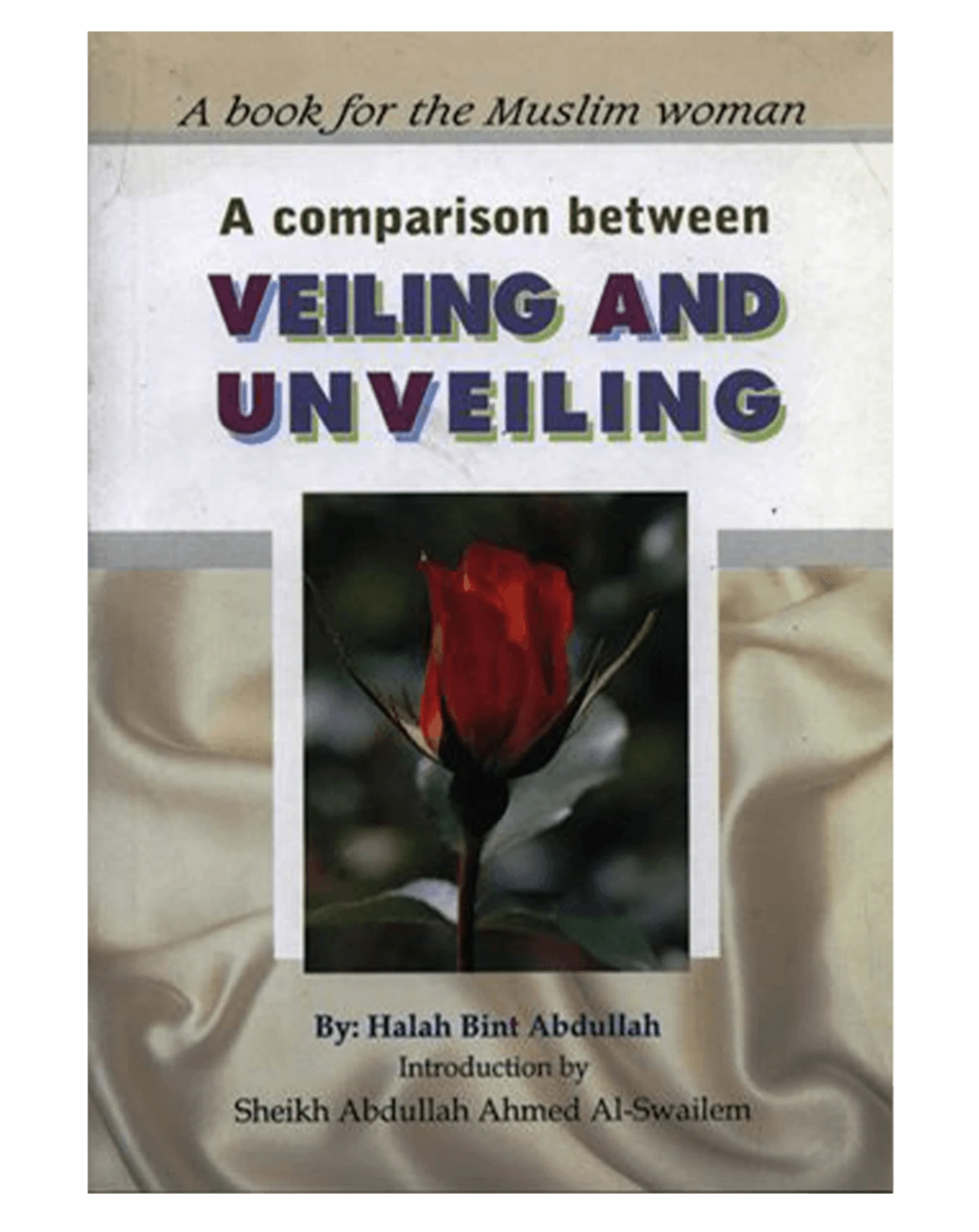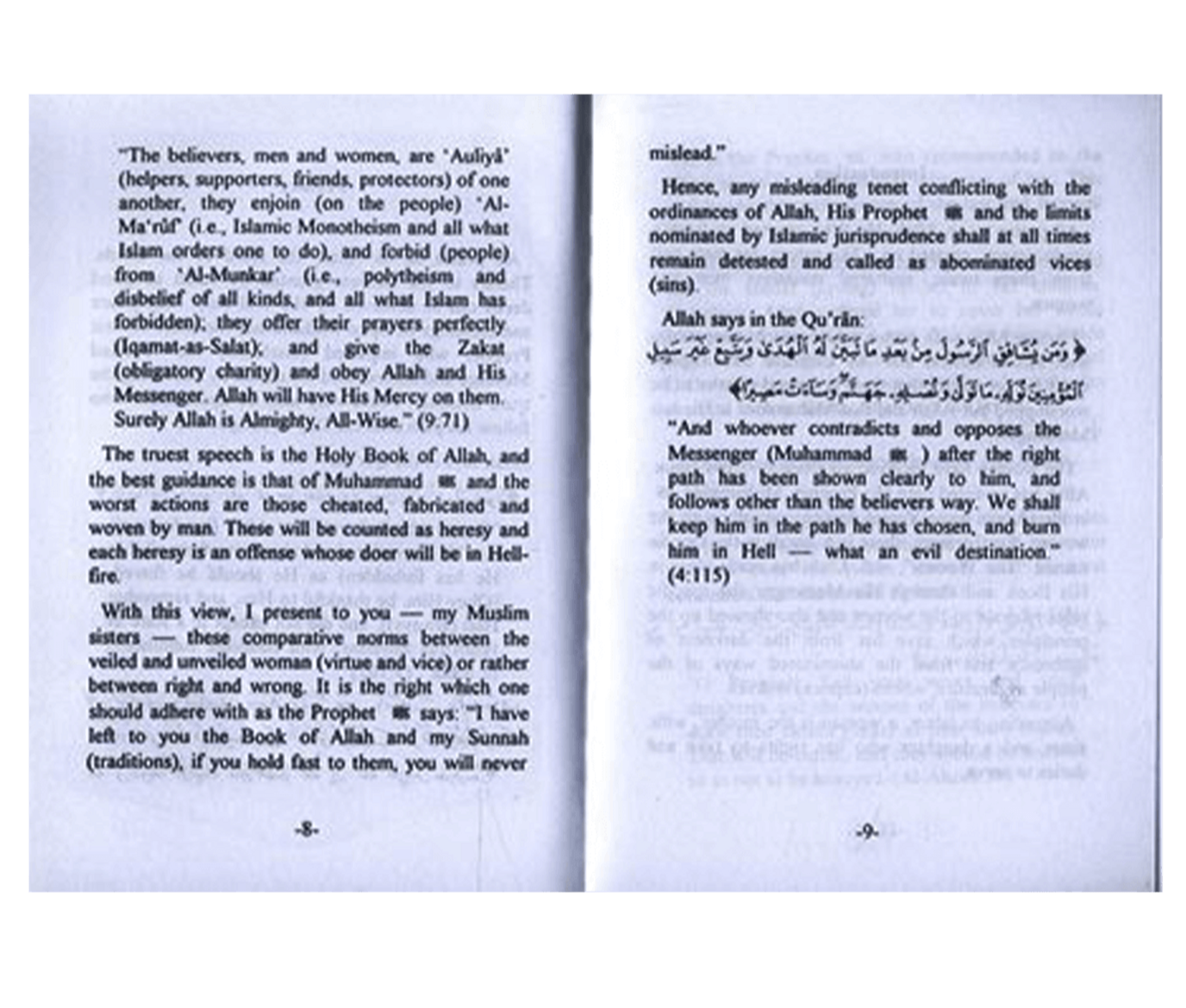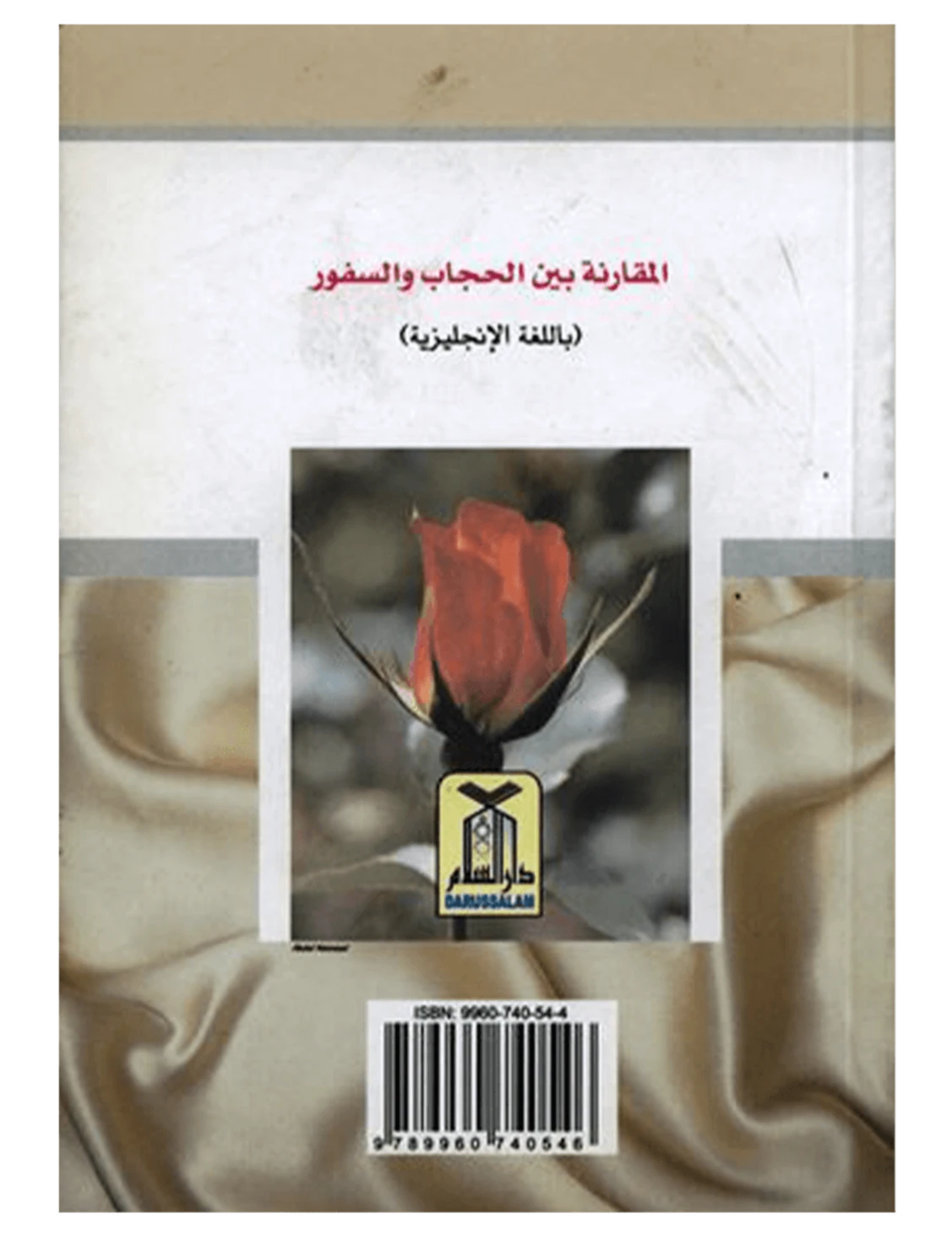A comparison between Veiling and Unveiling By Hala Bint Abdullah
A comparison between Veiling and Unveiling By Hala Bint Abdullah
Publisher:
Darussalam
Language:
English
Binding:
Soft Cover
Pages: 47
Size: 12x17cm
Couldn't load pickup availability



Collapsible content
Description of Book
A comparison between Veiling and Unveiling By Hala Bint Abdullah
In "Veiling and Unveiling", Hala Bint Abdullah delves into the intricate cultural, social, and political dynamics surrounding the concepts of veiling and unveiling, particularly within the context of Muslim women in the Arab world. The work is a nuanced examination of the duality of these practices, which are often seen as symbols of both oppression and empowerment. Abdullah provides a thoughtful and critical analysis, challenging oversimplified narratives about veiling and unveiling, and exploring how these practices shape and reflect women's identities and roles within their societies. This comparison between veiling and unveiling touches on various dimensions—religious, cultural, personal, and political—offering a rich and complex understanding of these practices.
1. The Symbolism of Veiling
Veiling, in Abdullah's analysis, is not just about the physical garment or covering, but about what it represents within the larger societal and cultural framework. Historically, veiling has been seen as a practice rooted in modesty, privacy, and adherence to religious or cultural codes. For many women, particularly in Muslim-majority societies, the veil symbolizes devotion to faith and tradition, acting as a marker of religious and social identity. Abdullah highlights how the veil, in this sense, is both a personal and collective symbol. It is deeply embedded in the socio-political fabric of many cultures, where women are often expected to wear it as a sign of respectability and conformity.
However, Abdullah also critiques the ways in which veiling has been politicized and used as a tool of control. The author acknowledges that while some women choose to wear the veil as an act of faith or personal conviction, in many cases, the veil is imposed by societal pressures, family expectations, or political ideologies. The veil, in this light, can symbolize restriction and conformity, particularly when women are forced to adopt it without agency or choice. Abdullah explores how these societal expectations can create an emotional burden, leading women to feel a sense of being trapped in a prescribed identity that does not necessarily align with their personal desires or beliefs.
2. The Act of Unveiling: Liberation or Conformity?
Unveiling, on the other hand, is often viewed as a symbolic act of liberation, a reclaiming of personal freedom, and a rejection of societal control. For many women, the decision to unveil is seen as a way to assert autonomy and embrace individualism. In a world where women are frequently judged based on their physical appearance, unveiling can be viewed as an act of defiance against the imposition of rigid standards of modesty or beauty. Abdullah’s exploration of unveiling, however, complicates this notion of liberation.
While unveiling might symbolize freedom for some, Abdullah notes that it can also be fraught with its own set of pressures and expectations. Unveiling does not always equate to true autonomy or freedom, as women in many societies are still judged by their looks or forced to conform to other societal standards of femininity and beauty. Abdullah suggests that unveiling, in some contexts, might not offer the empowerment it promises. Women who choose to unveil may still face societal scrutiny or marginalization, as unveiling does not necessarily dismantle the complex layers of gendered expectations that define a woman’s place in society. Abdullah's work raises important questions about whether unveiling is always a choice rooted in personal freedom or whether, in some cases, it is merely another form of societal expectation that women feel pressured to conform to.
3. Emotional and Psychological Dimensions
One of the most poignant aspects of Abdullah's analysis is her exploration of the emotional and psychological toll that both veiling and unveiling can have on women. For many, the decision to veil or unveil is not a simple matter of choice, but one that is influenced by deeply ingrained cultural values, family expectations, and personal convictions. The act of veiling, Abdullah argues, can lead to feelings of being invisible, restricted, or marginalized, especially when women are made to feel that their worth is defined by their adherence to cultural or religious dress codes.
On the other hand, unveiling can lead to its own set of psychological challenges. Women who choose to unveil may experience guilt, alienation, or backlash from their communities, especially if unveiling is perceived as a rejection of tradition or faith. Abdullah captures the inner conflict that many women experience as they navigate the societal pressures tied to their physical appearance, questioning whether they are truly exercising their autonomy or whether they are still shaped by external forces, even in the act of unveiling.
4. Cultural and Political Implications
Abdullah’s comparative analysis of veiling and unveiling is deeply informed by the socio-political context in which these practices occur. She examines how both practices are entangled with broader political and ideological debates about modernity, tradition, and the role of women in society. Veiling has often been politicized, with some regimes using it as a symbol of cultural or religious conservatism, while others have used it to promote a specific image of national identity. Similarly, unveiling has been used as a symbol of Westernization, progress, and women's liberation. Abdullah critiques the oversimplified narratives that reduce veiling and unveiling to mere symbols of oppression or freedom, pointing out that these practices are not inherently linked to a particular political or ideological stance.
By highlighting the political dimensions of veiling and unveiling, Abdullah emphasizes the ways in which women's bodies have been co-opted into larger struggles for power and identity. Whether it is in the context of Islamic fundamentalism or Western secularism, women are often caught in the middle of these ideological battles, forced to embody the cultural and political symbols of their respective societies. Abdullah calls for a more nuanced understanding of these practices, one that recognizes the diversity of women's experiences and the complexity of their choices.
5. Intersection of Identity, Freedom, and Choice
Ultimately, Veiling and Unveiling is an exploration of the intersection between identity, freedom, and choice. Abdullah’s work urges readers to move beyond binary frameworks that define women solely as either veiled or unveiled. Rather, she advocates for a deeper understanding of the diversity of women’s experiences, acknowledging that both veiling and unveiling are complex practices that can carry different meanings depending on the individual and the societal context.
Abdullah’s critical approach challenges readers to rethink the ways in which these practices are portrayed in global discourse. She calls for a recognition of the agency of women who choose to veil or unveil, acknowledging that these decisions are often shaped by personal beliefs, family dynamics, cultural values, and socio-political pressures. The veil is not simply a sign of oppression, nor is unveiling always an act of liberation. Instead, both practices are situated within a complex web of identity, freedom, and choice, where the individual’s voice and agency must be central to the conversation.
Publisher
Darussalam
Author
Sample Pages - Content
Page : 01
A book for the Muslim woman
A comparison between VEILING AND UNVEILING
By: Halah Bint Abdullah Introduction by
Sheikh Abdullah Ahmed Al-Swailem
Page : 02
"The believers, men and women, are 'Auliya' (helpers, supporters, friends, protectors) of one another, they enjoin (on the people) Al- Ma'ruf (ie, Islamic Monotheism and all what Islam orders one to do), and forbid (people) from Al-Munkar (ie, polytheism and disbelief of all kinds, and all what Islam has forbidden); they offer their prayers perfectly (Iqamat-as-Salat), and give the Zakat (obligatory charity) and obey Allah and His Messenger. Allah will have His Mercy on them. Surely Allah is Almighty, All-Wise." (9.71)
The truest speech is the Holy Book of Allah, and the best guidance is that of Muhammad and the worst actions are those cheated, fabricated and woven by man. These will be counted as heresy and each heresy is an offense whose doer will be in Hell- fire.
With this view, I present to you my Muslim sisters these comparative norms between the veiled and unveiled woman (virtue and vice) or rather between right and wrong. It is the right which one should adhere with as the Prophets says: "I have left to you the Book of Allah and my Sunnah (traditions), if you hold fast to them, you will never
mislead."
Hence, any misleading tenet conflicting with the ordinances of Allah, His Prophet and the limits nominated by Islamic jurisprudence shall at all times remain detested and called as abominated vices (sins).
Allah says in the Qu'ran:
وَمَن يُشَاقِقِ الرَّسُولَ مِنْ بَعْدِ مَا تَبَيَّنَ لَهُ الْهُدَى وَسَبِعْ غَيْرَ سَبِيلِ
المؤمنين توار مَا تَوا وَتُصْلِهِ جَهَنَّمَ وَسَاءَتْ مَصِيرًا)
"And whoever contradicts and opposes the Messenger (Muhammad) after the right path has been shown clearly to him, and follows other than the believers way. We shall keep him in the path he has chosen, and burn him in Hell what an evil destination." (4:115)
Page : 02
المقارنة بين الحجاب والسفور
(باللغة الإنجليزية)
Kan
DARUSSALAM
ISBN: 9960-740-54-4
789960 740546
Hala Bint Abdullah
Hala Bint Abdullah is a prominent scholar and writer known for her work on gender, culture, and societal issues, particularly in the context of the Arab world. Her work often explores themes such as the role of women in society, the intersections of tradition and modernity, and the complexities surrounding cultural practices like veiling and unveiling. In her writing, Abdullah critically examines how these practices shape women's identities and the ways they navigate autonomy, freedom, and societal expectations. Her analysis is nuanced, acknowledging the diverse experiences of women while challenging oversimplified views of cultural symbols and practices.



